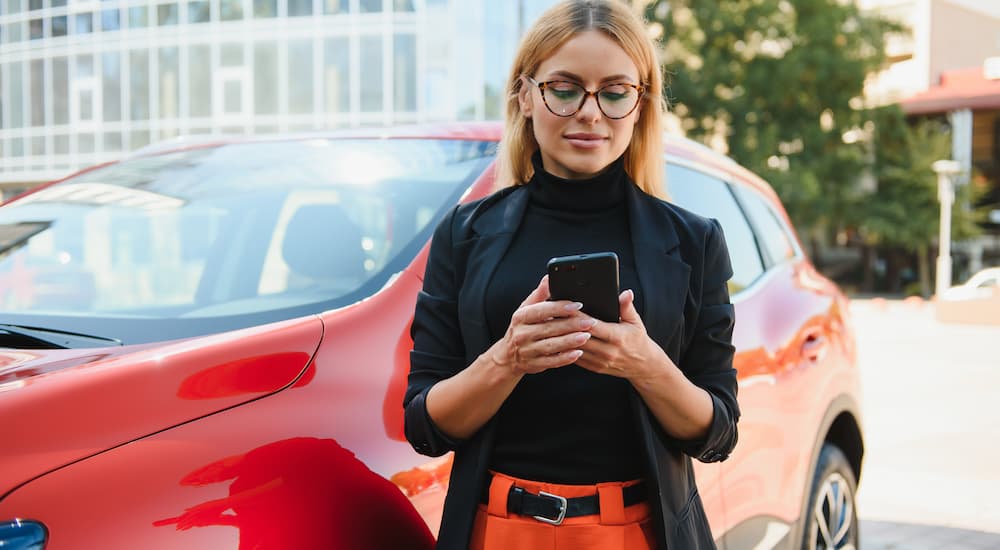Selling your car safely requires planning, attentiveness, and a great deal of caution to avoid potential scams and violent crimes. It would be great if this was the sort of world where you could decide, “I want to sell my car today,” and do so easily and without worry, but sadly it’s not. I’ll get into some specifics below, but the best general advice is to have your guard up and trust your instincts. If something feels wrong to you, then listen to that and take action to protect yourself. With that in mind, let’s take a look at some specific things you can do to safely sell your car.
Tip #1: Post Online Through a Reliable Website
One of the best ways to protect yourself when selling a car is to use an established website to act as a third party between you and potential buyers. Sites like Kelley Blue Book and Edmunds are great for this. While they won’t protect you directly, they let you post your listing without providing a lot of private information. Though, the best and safest course of action would be to sell your car directly to a dealership. Selling your car to a friend or family member can also eliminate a lot of the unknown, but that can have other issues (anything involving family and money can get complicated).
Tip #2: Never Give Out Personal Information
No matter how you list your vehicle to sell, never provide your personal information with the listing. People don’t need to know your name, address, or even your phone number since these sites allow them to contact you initially through the listing. You should insist on a phone call at a certain point (more below), but don’t just put that information out there. Similarly, make sure any documents you might need to provide, like service records for the vehicle, don’t have any private information on them. Use a black permanent marker to strike out any personal information on these sorts of documents before showing them or giving them to a buyer. Again, this is something that would be easily remedied by selling to a reputable dealership.
Tip #3: Insist on a Phone Call Before a Test Drive
Before meeting someone for them to take a test drive, insist on talking to them on the phone first. During the phone call, ask them questions about what they’re looking for and use this as an opportunity to set up where to meet, the route of the test drive, and other details. You should expect them to ask you questions, too. If they’re not asking questions, that’s a red flag that they’re not serious about buying or that their interest isn’t just in the vehicle.

Tip #4: Always Meet in a Public, Busy Location
If everything seems good and you want to meet a potential buyer for them to take a test drive, agree to meet them at a public location with lots of other people. Do not give someone your home address to meet at or your place of business. Choose a mall parking lot or a similar shopping center. Meet in a location with lots of other people and good visibility from nearby streets and businesses. There are no guarantees in life, but potential attackers are less likely to assault someone if they can easily be seen. This is another situation in which selling to a dealership would be easier. Once you’ve signed your paperwork and left their lot, you won’t have to worry about a test drive or meeting potential buyers.
Tip #5: Plan Out Your Test-Drive Route Ahead of Time
During a phone call, if things seem good and you’re willing to meet so they can take a test drive, you should plan the route of the test drive with the potential buyer. The route should be relatively short, though it’s normal for it to include both city streets and freeways so they can get a good feel for how it drives. Provide this route information to other people, like friends and family, just so they know where you expect to be.
Tip #6: Never Meet Alone
When you agree to meet a potential buyer, ask them who you’ll be meeting. Is it just them, or will they bring someone with them? You should make sure you have someone come with you, a friend or family member, and let the buyer know you won’t be coming alone. If someone is looking for a potential victim, they’re far less likely to try something if you’re not alone––particularly if they are outnumbered. Safety in numbers is a very real thing sometimes.
Along these lines, always go with the potential buyer on the test drive and have whoever comes with you along too. Before you give the buyer the keys, see their driver’s license and proof of insurance. Take a picture of their license with your phone and send it to someone else. You don’t have to be sneaky about this; let the potential buyer know that you’re taking steps to protect yourself. It can help deter any malicious thoughts they might have.
Tip #7: Never Go to a Second Location
Never, ever drive a potential buyer to another location outside of where you agreed to meet and the test drive route, which should end back at that same public location. A common tactic is for someone to agree to all of this, take the test drive, and seem happy with things, then they’ll say they need to go to another place to pick up the payment. Tell them to go there and then come back, or that you will drive separately and meet them at the bank they need to go to.
Don’t drive them to another location away from where you agreed to be. This is a very easy way for someone to get a potential victim away from public view or where people know they are located. Even if it sounds innocent, you should always protect yourself and act in a way that keeps you safe.
Tip #8: Insist on Safe and Secure Payment
The potential for violent crimes from a stranger is only one concern when selling a vehicle. You also have to look out for scams and financial crimes. There are so many different scams that people use to get cars or other property from victims that I can’t possibly detail them all here. The best way to protect yourself is to insist on payment that you know is secure. Cash is probably the safest option, but not a lot of people are comfortable bringing that much money with them to meet a stranger––consider their perspective too.
A cashier’s check is a fantastic option, though you should insist on meeting them after the test drive at their bank. Remember, don’t drive them there. Go into the bank with them to see that they draw the cashier’s check from their account in order to avoid potential fakes and scams. Never accept a personal check for the sale of a vehicle unless the buyer is willing to wait several weeks until the check actually clears to take possession of it (not likely). Digital money transfers through services like Zelle or Venmo can work, but they’re also rife with scams, so be very careful whenever you agree to that sort of payment.
If you are looking for a quick and secure way to get paid for your vehicle, selling to a dealership would be the best solution in this case. You do not have to worry about a fraudulent payment. You do not have to follow anyone to a bank for a cashier’s check, and you can walk away with cash in hand.

Tip #9: Make Sure You Fill Out All Paperwork Properly
Even if you’re dealing with a legitimate buyer, you still need to do everything correctly when selling your vehicle to protect yourself. Take some time to look into what’s required in your state to sell a vehicle, and make sure you fill out all of the necessary paperwork correctly. When you indicate the odometer reading, write down the precise number, don’t round up by five miles, because what if they get into a crash two miles after taking the vehicle from you? They could claim you still owned the vehicle at that time.
Similarly, don’t show them the title of the vehicle or give it to them until you know that payment has actually gone through for the vehicle. Only then should you sign the title and present it to them. Once they have that paper, they own the car no matter what. Keep your car insurance until you know the vehicle is no longer registered in your name. Remove the license plates, and depending on your state, you might need to turn them in to make everything official.
Tip #10: File a “Notice of Transfer and Release of Liability” Form Immediately
Finally, once you’ve received payment and signed over the title, file a “Notice of Transfer and Release of Liability” form at your state’s motor vehicle department or agency immediately. This indicates that you are no longer the legal owner of the vehicle and that you’re not liable for anything involving it. Without doing this, you could still be on the hook for whatever the new driver does if they’re slow to register the vehicle.
Be Smart About Selling to Stay Safe
With all of these steps necessary to try to protect yourself, you can see why it may be the best course of action to sell your vehicle to a dealership rather than handling everything yourself. You’ll just have to find a dealership that is safe, reliable, and that will handle all of these details for you. However, selling privately isn’t an impossible task. Just make sure you are being smart whenever you meet a potential buyer and that you have all of your paperwork in order.



